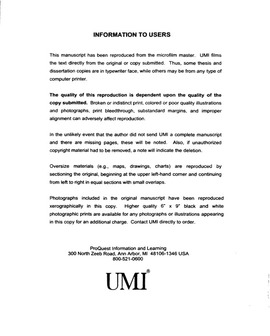| dc.contributor.advisor | Gramoll, Kurt, | en_US |
| dc.contributor.author | Sun, Qiuli. | en_US |
| dc.date.accessioned | 2013-08-16T12:18:23Z | |
| dc.date.available | 2013-08-16T12:18:23Z | |
| dc.date.issued | 2001 | en_US |
| dc.identifier.uri | https://hdl.handle.net/11244/365 | |
| dc.description.abstract | The concept of collaborative design and analysis using the Internet was investigated and implemented. Geographically dispersed users can build the same geometric model simultaneously over the Internet and communicate with each other through a chat room. They can also conduct finite element analysis collaboratively on the same object over the Internet. They can mesh the same object, apply and edit the same boundary conditions and forces, obtain the same analysis results, and then discuss the results through the Internet. | en_US |
| dc.description.abstract | The online database was designed to manage the changeable data related to the environment. The virtual world was used to implement 3D visualization and tie the multimedia modules together. Students are allowed to build segments of the 3D virtual world upon completion of appropriate undergraduate courses in civil engineering. The end result is a complete virtual world that contains designs from all of their coursework and is viewable on the Internet. The environment is a content-rich educational system, which can be used to teach multiple engineering topics with the help of 3D visualization, animations, and simulations. | en_US |
| dc.description.abstract | This research investigates the use of the Internet for engineering education, design, and analysis through the presentation of a Virtual City environment. The main focus of this research was to provide an infrastructure for engineering education, test the concept of distributed collaborative design and analysis, develop and implement the Virtual City environment, and assess the environment's effectiveness in the real world. A three-tier architecture was adopted in the development of the prototype, which contains an online database server, a Web server as well as multi-user servers, and client browsers. The environment is composed of five components, a 3D virtual world, multiple Internet-based multimedia modules, an online database, a collaborative geometric modeling module, and a collaborative analysis module. The environment was designed using multiple Intenet-based technologies, such as Shockwave, Java, Java 3D, VRML, Perl, ASP, SQL, and a database. These various technologies together formed the basis of the environment and were programmed to communicate smoothly with each other. Three assessments were conducted over a period of three semesters. The Virtual City is open to the public at www.vcity.ou.edu. | en_US |
| dc.format.extent | xx, 243 leaves : | en_US |
| dc.subject | Education, Sciences. | en_US |
| dc.subject | Engineering Study and teaching. | en_US |
| dc.subject | Education, Technology of. | en_US |
| dc.subject | Distance education. | en_US |
| dc.subject | Internet in education. | en_US |
| dc.subject | Engineering, Mechanical. | en_US |
| dc.title | Internet-based distributed collaborative environment for engineering education and design. | en_US |
| dc.type | Thesis | en_US |
| dc.thesis.degree | Ph.D. | en_US |
| dc.thesis.degreeDiscipline | School of Aerospace and Mechanical Engineering | en_US |
| dc.note | Adviser: Kurt Gramoll. | en_US |
| dc.note | Source: Dissertation Abstracts International, Volume: 62-09, Section: B, page: 4191. | en_US |
| ou.identifier | (UMI)AAI3025981 | en_US |
| ou.group | College of Engineering::School of Aerospace and Mechanical Engineering | |
